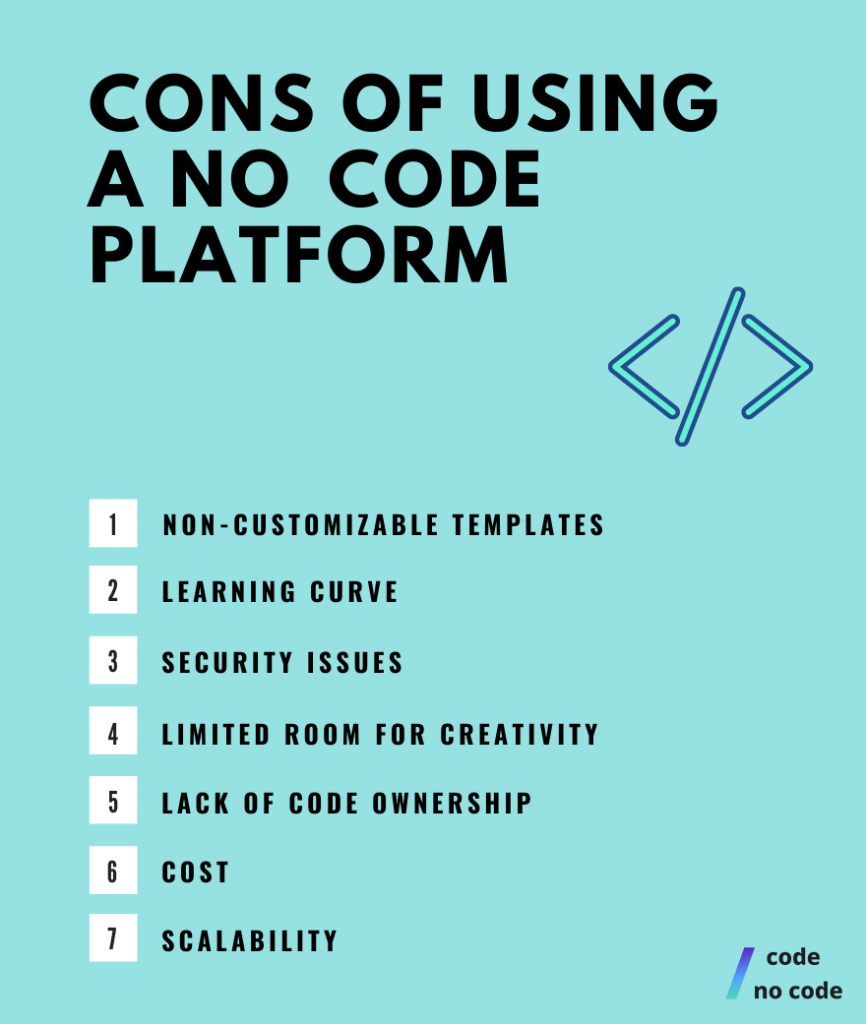
Top 10 Best Outsourced Product Development Companies
The year is 2024. Outsourcing, once the boogeyman of corporate development horror stories (“They took our jobs!”) has now become a badge of honor—a cunning strategy adopted...
As we are marching towards a digital revolution, the power in software development is shifting from developers to innovative thinkers. No Code platforms were developed to make software development easy for non-coders.

People have started experimenting with the development of complex technology like AI with No Code[1]. Some people think it can completely put developers out of work. That’s incorrect. Today, we are going to tell you about some of the No Code drawbacks.
Below are 7 disadvantages of No Code platform, and reasons why they may actually not be a good idea.
Most No Code platforms are marketed based on the available range of templates. They come equipped with various drag-and-drop templates for every feature you might need in your software. However, the problem with these templates is that they are not customizable. You have to stay within the limits of the template.
If you are looking for specific logic and can’t find it in one of the templates of your No Code software development tool, you don’t have much of a choice. But it’s not a completely dark tunnel. There are a few No Code platforms like Bubble, which have the ability to customize these templates according to your needs[2]. Doing so might require the knowledge of programming languages, however, which might a little much for non-technical users.
Since it has been advertised that the learning curve of No Code is easy, people are living in a delusion that anyone can easily create genius mobile apps within a few days. That’s a bit of a stretch. Although it is easy to start developing with many No Code platforms, making a good app requires some understanding of the technical side of product development: User Interfaces, Heatmaps, User Experience, and Information Architecture.
If you are ready to learn these, you will no longer stay attached to No Code platforms. It will become almost tempting to shift to a Low Code development platform.

There is little to no control over the code in your app. Even though these platforms have great base security guidelines, you are only as secure as your platform is. This leads to greater risks of security for the software or website developed with No Code platforms.
Security and privacy are the top priorities of software developers and users. This is one of the biggest disadvantages of using a No Code platform. In case there is a data breach in the company where you developed your software, all of your user data is at risk.
In addition, security issues arise when citizen developers use a No Code development platform with little knowledge of software development. You might make your app insecure due to not knowing how to hide backend information, set up secure logins or an ‘https’ domain.
As mentioned earlier, since everything is templatized in presets, you lack room for creativity. You are tied with the features provided by the platform. Now, you must be thinking “what if I want to create additional complex features?” Well, guess what? You will have to find a way to work with the limitations to fulfil your requirements.
If you are still not convinced and adamant about adding a feature your way, you have to manually add the code, which is only generally possible with Low Code platforms.

No Code platforms are great to provide you with a head start in product development. But once you have developed the product, you might run into vendor lock-in problems.
Vendor lock-in happens when you are stuck with one vendor regardless of the quality of their services. Your dependency on this No Code platform will rise. This results in you having no ownership of the code at all.
This is a clear disadvantage especially when compared with Low Code development platforms which offer more portability and openness than No Code solutions.
There are exceptions to this limitation though. You can use a No Code platform like ycode.com[3] that will allow you to export your code at a later date.
At the initial level of your startup, this might not sound like a big deal, but as you grow, code ownership becomes a vital part of the business model.
“No Code platforms are cost-effective” is something we hear a lot of. However, people who say that are comparing the charges of hiring a developer to do the coding vs the subscription fees of the platform.
This comparison does not look at the output quality, nor does it take into consideration your time spent learning the platform: learning a No Code platform can take significant time, and if you have no experience with traditional development, the learning curve is even steeper.

Of course, learning to use a No Code development platform is still much quicker when compared to a Low Code development platforms or code development.
In general though, the amount of time you spend on a platform learning how it works could be put to better use actually developing the business processes of your product.
Moreover, there is no guarantee that the final product will be up to par with what you were expecting. This is because most No Code software offers limited design customisation and feature flexibility.
In conclusion, the cost of using a No Code platform can be high when compared to the costs of hiring a developer for the job.
Let’s say you start developing your project with the No Code approach and halfway to the finish you realize that you might want to add custom code to sustain your application.
Due to your lack of knowledge in coding, you hire a developer. This would end up being more expensive than hiring developers in the first place.
Therefore, hiring No Code developers right from the get-go is usually a wise choice.
These experts usually know the ins and outs of the tools they use and can use their biggest advantage, the lightning-fast development speed, to develop sustainable solutions for you quickly and cheaply.

Every successful organization gets to a point where they need scalability in their application. Most of these fast or “cost-effective” No Code software development platforms are not easily scalable. And if they are, it comes with an extra charge.
Companies might refrain from paying an extra amount since they lack code ownership as well. That’s one of the reasons why companies shift to either Low Code or custom software development (and write code) after achieving a milestone of, for example, 100,000 users.
For more information on No Code in general, its uses in other business spheres and its future, read our article on What is No Code.
Still not sure about which approach to use, code or No Code? Take our 3-minute quiz and find out.